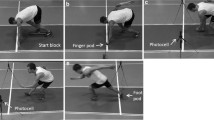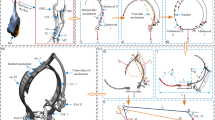Abstract
This work presents the performance evaluation of an ultra-wide band (UWB) positioning system for monitoring athletes in sports. Focusing on a five-a-side football scenario, the objective of this paper is to evaluate the performance of the proposed UWB positioning system by considering three different heights of the receiver antenna: 1 m, 1.6 m and 2 m. The system consists of four static UWB receivers placed at the corners of the pitch, while a player is equipped with an UWB transmitter worn on the upper back of the body. The UWB communication link from the on-body transmitter to the receivers can be influenced by the relative height between the transmitting and the receiving antenna. In order to assess the performance of the positioning system, on-field tests have been performed with five players. The players were asked to run at a variable speed while traveling a predefined path inside the pitch. Three metrics have been considered to assess the system performance: the accuracy of the position for each player, the percentage of packets lost by each receiver with respect to the total number of transmitted packets, and the percentage of packets respectively received by one, two, three, and four anchors, with respect to the total number of transmitted packets. The experimental results show that the intermediate height of 1.6 m for the receiver antenna presents the best results: the lowest value of position RMSE (equal to 31 cm), an average of 28% of the lost transmitted packets and an average of 63% of the transmitted packets being received at least by 3 anchors.









Similar content being viewed by others
References
P. D. Groves, Principles of GNSS, Inertial, and Multisensor Integrated Navigation Systems, vol. 2nd, Artech HouseNorwood, 2013.
E. Kaplan and C. Hegarty, Understanding GPS/GNSS: Principles and Applications, vol. 3rd, Artech HouseNorwood, 2017.
A. Martinelli, H. Gao, P. D. Groves and S. Morosi, Probabilistic Context-aware Step Length Estimation for Pedestrian Dead Reckoning,IEEE Sensors, Vol. 18, pp. 1600–1611, 2018.
K. Roebuck, Location-Based Services (LBS). Lightning Source, ElsevierAmsterdam, 2011.
A. Küpper, Location-Based Services: Fundamentals and Operation, marketsandmarkets.comTC 2371 (2005).
A. Basiri, T. More, C. Hill and P. Bhatia, Challenges of Location-Based Services Market Analysis: Current Market Description, Progress in Location-Based Services, Springer 47, pp. 1–10 (2014).
E.G. Agency, Location-Based Services (LBS), https://www.gsa.europa.eu/segment/location-based-services-lbs (2011).
R. Leser, A. Baca and G. Ogris, Local positioning Systems in (Game) Sports, Sensors, Vol. 11, pp. 9778–9797, 2011.
L. Mucchi, F. Trippi and A. Carpini, Ultra Wide Band real-time location system for cinematic survey in sports, 3rd International Symposium on Applied Sciences in Biomedical and Communication Technologies (ISABEL), Rome, Italy (2010).
A. Alarifi, A. Al-Salman, M. Alsaleh, A. Alnafessah, S. Al-Hadhrami, M. A. Al-Ammar and H. S. Al-Khalifa, Ultra wideband indoor positioning technologies: analysis and recent advances, Sensors, Vol. 16, p. 707, 2016.
K.M. Tan and C.L. Law, GPS and UWB Integration for indoor positioning, International Conference on Information, Communications and Signal Processing (2007).
F. Nekoogar, Ultra-Wideband Communications, Fundamentals and Applications, Prentice Hall PTRUpper Saddle River, 2011.
M. Paoli, A. Agili, E. Panzi, A. Cimbalo, A. Martinelli, S. Morosi and L. Mucchi, Individual Tracking Method and System, Italy Patent Pending, No 102017000062080 (UA2017A004096) (June 2017).
M. Gilgien, J. Spörri, P. Limpach, A. Geiger and E. Müller, The Effect of Different Global Navigation Satellite System Methods on Positioning Accuracy in Elite Alpine Skiing, Sensors, Vol. 14(10), pp. 18433–18453, 2014.
S. Zihajehzadeh, D. Loh, T. Lee, R. Hoskinson and E. J. Park, A Cascaded Kalman Filter-Based GPS/MEMS-IMU Integration for Sports Applications, Measurements, Elsevier, Amsterdam, 2015.
A. Foina, R. Badia, A. El-Deeb and F.J. Ramirez-Fernandez, Player Tracker - a Tool to Analyze Sport Players Using RFID, International Conference on Pervasive Computing and Communications Workshops, 2010.
M. Ji, J. Kim, J. Jeon and Y. Cho, Analysis of Positioning Accuracy Corresponding to the Number of BLE Beacons in Indoor Positioning System, International Conference on Advanced Communication Technology, 2015.
M. Ridolfi, S. Vandermeeren, J. Defraye, H. Steendam, J. Gerlo, D. D. Clercq, J. Hoebeke and E. D. Poorter, Experimental Evaluation of UWB Indoor Positioning for Sport Postures. Measurements, Elsevier, Amsterdam, 2018.
H. K. Chavda and M. Dhamecha, Moving object tracking using PTZ camera in video surveillance system, International Conference on Energy, Communication, Data Analytics and Soft Computing, 2017.
S. X. Liu, L. Jiang, J. Garner and S. Vermette, Video Based Soccer Ball Tracking, Southwest Symposium on Image Analysis and Interpretation, 2010.
S. Morosi, A. Martinelli and E. D. Re, Peer-to-peer cooperation for GPS positioning, International Journal of Satellite Communications and Networking, Vol. 35, pp. 323–341, 2017.
D. Jennings, S. Cormack, A. Coutts, L. Boyd and R. Aughey, The Validity and Reliability of GPS Units for Measuring Distance in Team Sport Specific Running Patterns, International Journal of Sport Physiology and Performance, Vol. 5, pp. 328–341, 2010.
S. Jin, Global Navigation Satellite Systems: Signal, Theory and Application, Intech New York, 2012.
Y. Wang, X. Yang,Y. Zhao, Y. Liu and L. Cuthbert, Bluetooth positioning using RSSI and triangulation methods, 10th Consumer Communications and Networking Conference, 2013.
C. Yang and H. Shao, Bluetooth positioning using RSSI and triangulation methods, IEEE Communications Magazine, 2015.
Decawave Company. https://www.decawave.com/
A. Martinelli, M. Dolfi, S. Morosi, L. Mucchi, M. Paoli and A. Agili, Ultra-wide Band Positioning in Sport: How the On-body Tag Location Affects the System Performance, International Conference on Body Area Networks (BODYNETS), 2018.
C. McElroy, D. Neirynck and M. McLaughlin, Comparison of Wireless Clock Synchronization Algorithms for Indoor Location Systems, International Conference on Communications Workshops (ICC), 2014.
J. Stefanski, Hyperbolic Position Location Estimation in the Multipath Propagation Environment, Wireless and Mobile Networking, Springer Berlin, Heidelberg, pp. 232–239, 2009.
Espressif Systems Company. https://www.espressif.com
Author information
Authors and Affiliations
Corresponding author
Additional information
Publisher's Note
Springer Nature remains neutral with regard to jurisdictional claims in published maps and institutional affiliations.
Rights and permissions
About this article
Cite this article
Martinelli, A., Dolfi, M., Morosi, S. et al. Ultra-wide Band Positioning in Sport: How the Relative Height Between the Transmitting and the Receiving Antenna Affects the System Performance. Int J Wireless Inf Networks 27, 18–29 (2020). https://doi.org/10.1007/s10776-019-00470-7
Received:
Revised:
Accepted:
Published:
Issue Date:
DOI: https://doi.org/10.1007/s10776-019-00470-7




